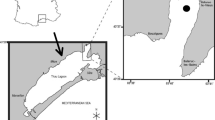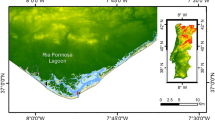Abstract
We examined heterotrophic bacterial nutrient limitation at four sites in Florida Bay, U. S. in summer 1994 and winter 1995. Bacterial growth and biomass production in this system were most limited by inorganic phosphorus (P) in the eastern and southern regions of the bay. Nutrient additions stimulated productivity and biomass accumulation mostly in summer. The magnitude of growth responses (thymidine incorporation) to nutrient additions was nearly an order of magnitude less in winter than summer. Biomass-normalized alkaline phosphatase activity in the northeast and south-central region was 5–20 times greater than in the northwest and north-central regions, suggesting that P is most limiting to planktonic growth in those areas. Chlorophyll levels were higher in the northwest and north-central regions and P-uptake into particles >1 μm, primarily phytoplankton, was also higher in these regions. Consistent with these observations, others have observed that P is advected into the bay primarily in the northwestern region. Abundant seagrasses in Florida Bay may promote heterotrophic bacterial production relative to phytoplankton production by releasing dissolved organic carbon that makes bacteria more competitive for limiting quantities of inorganic phosphate, especially in the eastern bay where turbidity is low, P is most limiting, and light levels reaching the benthic plants are high.
Similar content being viewed by others
Literature Cited
American Public Health Association 1992. Standard Methods for the Examination of Water and Wastewater, 18th edition. American Public Health Association, Washington, D.C.
Anderson, B., R. S. Scalon, E. W. Behrens, andP. L. Parker. 1992. Stable carbon isotope variations in sediment from Baffin Bay, Texas, U.S.A.: Evidence for cyclic changes in organic matter source.Chemical Geology 101:223–233.
Atkinson, M., andS. Smith. 1983. C:N:P ratios of benthic marine plants.Limnology and Oceanography 28:568–574.
Azam, F., T. Fenchel, J. G. Field, J. S. Gray, L. A. Meyer-Reil, andF. Thingstad. 1983. The ecological role of water-column microbes in the sea.Marine Ecology Progress Series 10:257–263.
Biddanda, B., S. Opsahl, andR. Benner. 1994. Plankton respiration and carbon flux through bacterioplankton on the Louisiana shelf.Limnology and Oceanography 39:1259–1275.
Biddanda, B., M. Ogdahl, and J. B. Cotner. In press. Contribution of heterotrophic bacteria to plankton biomass and respiration in lakes and the ocean.Limnology and Oceanography.
Bratbak, G. 85. Bacterial biovolume and biomass estimations.Applied and Environmental Microbiology 49:1488–1493.
Brylinsky, M. 1977. Release of dissolved organic matter by some marine macrophytes.Marine Biology 39:213–220.
Bugden, J. B. C., M. A. Guerrero, andR. D. Jones. 1998. Spatial and temporal variation of marine bacterioplankton in Florida Bay, U.S.A.Journal of Coastal Research 14:1304–1313.
Chin-Leo, G., and R. Benner. 92. Enhanced bacterioplankton production and respiration at intermediate salinities in the Mississippi River plume.Marine Ecology Progress Series 87:87–103.
Coffin, R. B., J. P. Connolly, andP. S. Harris. 1993. Availability of dissolved organic carbon to bacterioplankton examined by oxygen utilization.Marine Ecology Progress Series 101:9–22.
Corbett, D. R., J. Chanton, W. Burnett, K. Dillon, C. Rutkowski, andJ. W. Fourqurean. 1999. Patterns of groundwater discharge into Florida Bay.Limnology and Oceanography 44: 1045–1055.
Cotner, J. B., J. A. Ammerman, E. R. Peele, andE. Bentzen. 1997. Phosphorus limited bacterioplankton growth in the Sargasso Sea.Aquatic Microbial Ecology 13:141–149.
Cotner, Jr.,J. B. andR. G. Wetzel. 1992. Uptake of dissolved inorganic and organic phosphorus compounds by phytoplankton and bacterioplankton.Limnology and Oceanography 37:232–243.
Coveney, M. F., andR. G. Wetzel. 1988. Experimental evaluation of conversion factors for the [3H]thymidine incorporation assay of bacterial secondary productivity.Applied and Environmental Microbiology 54:2018–2026.
Currie, D. J., andJ. Kalff. 1984a. A comparison of the abilities of freshwater algae and bacteria to acquire and retain phosphorus.Limnology and Oceanography 29:298–310.
Currie, D. J., andJ. Kalff. 1984b. The relative importance of bacterioplankton and phytoplankton in phosphorus uptake in freshwater.Limnology and Oceanography 29:311–321.
Fourqurean, J. W., R. D. Jones, andJ. C. Zieman. 1993. Processes influencing water column nutrient characteristics and phosphorus limitation of phytoplankton biomass in Florida Bay, FL., USA: Inferences from spatial distributions.Estuarine, Coastal and Shelf Science 36:295–314.
Fourqurean, J. W., J. C. Zieman, andG. V. N. Powell. 1992. Phosphorus limitation of primary production in Florida Bay: Evidence from C:N:P ratios of the dominant seagrass.Thalassia testudinum. Limnology and Oceanography 37:161–171.
Fuhrman, J. A. andF. Azam 1982. Thymidine incorporation as a measure of heterotrophic bacterioplankton production in marine surface waters: Evaluation and field results.Marine Biology 66:109–120.
Gardner, W. S. andP. A. St. John. 1991. High-performance liquid chromatographic method to determine ammonium ion and primary amines in seawater.Analytical Chemistry 63: 537–540.
Griffith, P. C., D. J. Douglas, andS. C. Wainright. 1990. Metabolic activity of size-fractionated microbial plankton in estuarine, nearshore, and continental shelf waters of Georgia.Marine Ecology Progress Series 59:263–270.
Havens, K. E., T. L. East, R. H. Meeker, W. P. Davis, andA. D. Steinman. 1996. Phytoplankton and periphyton responses to in situ experimental nutrient enrichment in a shallow subtropical lake.Journal of Plankton Research 18:551–566.
Healey, F. P. andL. L. Hendzel. 1979. Fluorometric measurement of alkaline phosphatase activity in algae.Freshwater Biology 9:429–439.
Hecky, R. E., P. Campbell andL. L. Hendzel. 1993. The stoichiometry of carbon, nitrogen, and phosphorus in particulate matter of lakes and oceans.Limnology and Oceanography 38: 709–724.
Hobbie, J. E., R. J. Daley, andS. Jasper. 1977. Use of Nucleopore filters for counting bacteria by fluorescence microscopy.Applied and Environmental Microbiology 33:1225–1228.
Hoppe, H. 3. Use of fluorogenic model substrates for extracellular enzyme activity (EEA) measurement of bacteria, p. 423–431.In P. F. Kemp, B. F. Sherr, E. B. Sherr, and J. J. Cole (eds.), Handbook of Methods in Aquatic Microbial Ecology. Lewis Publishers, Boca Raton, Florida.
Kirchman, D. 0. Limitation of bacterial growth by dissolved organic matter in the subarctic Pacific.Marine Ecology Progress Series 62:47–54.
Lavrentyev P. J., H. A. Bootsma, T. H. Johengen, J. F. Cavaletto, andW. S. Gardner. 1998. Microbial plankton response to resource limitation: Insights from microbial plankton structure and seston elemental stoichiometry in Florida Bay.Marine Ecology Progress Series 165:45–57.
Lee, S. and J. A. Fuhrman. 987. Relationships between biovolume and biomass of naturally derived marine bacterioplankton.Applied and Environmental Microbiology 53:1298–1303.
Montague, C. L. andJ. A. Ley 1993. A possible effect of salinity fluctuation on abundance of benthic vegetation and associated fauna in northeastern Florida Bay.Estuaries 16:703–717.
Moran, M., andR. Hodson. 1989. Formation and bacterial utilization of dissolved organic carbon derived from detrital lignocellulose.Limnology and Oceanography 34:1034–1047.
Moriarty, D. J. W., R. L. Iverson, andP. C. Pollard. 1986. Exudation of organic carbon by the seagrassHalodule wrightii Aschers. and its effect on bacterial growth in the sediment.Journal of Experimental Marine Biology and Ecology 96:115–126.
Morris, D. P., andW. M. J. Lewis. 1992. Nutrient limitation of bacterioplankton growth in Lake Dillon, Colorado.Limnology and Oceanography 37:1179–1192.
Phlips, E. J., T. C. Lynch, andS. Badylak. 1995. Chlorophyll a, tripton, color, and light availability in a shallow tropical innershelf lagoon, Florida Bay, USA.Marine Ecology Progress Series 127:223–234.
Pomeroy, L. R., J. E. Sheldon, W. M. Sheldon, andF. Peters. 1995. Limits to growth and respiration of bacterioplankton in the Gulf of Mexico.Marine Ecology Progress Series 117:259–268.
Fedfield, A. C. 1958. The biological control of chemical factors in the environment.American Scientist 46:205–221.
Rudnick, D. T., Z. Chen, D. L. Childers, J. N. Boyer, andT. D. Fontaine III. 1999. Phosphorus and nitrogen inputs to Florida Bay: The importance of the Everglades watershed.Estuaries 22:398–416.
Scheffer, M., S. H. Hosper, M.-L. Meijer, B. Moss, andE. Jeppesen. 1993. Alternative equilibria in shallow lakes.Trends in Ecology and Evolution 8:275–279.
Sharp, J. H., R. Benner, L. Bennett, C. A. Carlson, R. Dow, andS. E. Fitzwater. 1993. Re-evaluation of high temperature combustion and chemical oxidation measurements of disolved organic carbon in seawater.Limnology and Oceanography 38:1774–1782.
Smith, S. 1984. Phosphorus versus nitrogen limitation in the marine environment.Limnology and Oceanography 29:1149–1160.
Strickland, J. D. H., andT. R. Parsons. 1972. A Practical Handbook of Seawater Analysis, 2nd edition. Fisheries Research Board of Canada, Ottawa, Canada
Sugimura, Y., andY. Suzuki. 1988. A high temperature catalytic oxidation method for nonvolatile dissolved organic carbon in seawater by direct injection of liquid samples.Marine Chemistry 24:105–131.
Suttle, C., andP. Harrison. 1988. Ammonium and phosphate uptake kinetics of size-fractionated plankton from an oligotrophic freshwater lake.Journal of Plankton Research 10:133–149.
Thingstad, T. F., andF. Rassoulzadegan. 1995. Nutrient limitations, microbial food webs, and “biological C-pumps”: Suggested interactions in a P-limited Mediterranean.Marine Ecology Progress Series 117:299–306.
Thingstad, T. F., E. F. Skjoldal, andR. A. Bohne. 1993. Phosphorus cycling and algal-bacterial competition in Sandsfjord, Western Norway.Marine Ecology Progress Series 99:239–259.
Tomas, C. R., B. Bendis, andK. Johns. 1999. Role of nutrients in regulating plankton blooms in Florida Bay, p. 323–337.In H. Kumpf, K. Steidinger, and K. Sherman (eds.), The Gulf of Mexico Large Marine Ecosystem: Assessment, Sustainability, and Management, Blackwell Science, Malden, Massachusetts.
Toolan, T., J. D. Wehr, andS. Findlay. 1991. Inorganic phosphorus stimulation of bacterioplankton production in a mesoeutrophic lake.Applied and Environmental Microbiology 57:2074–2078.
U.S. Environmental Protection Agency 1974. Methods for Chemical Analysis of Water and Wastes, V. 625-/6-74-003a. Environmental Protection Agency, Cincinnati, Ohio.
Vadstein, O., A. Jensen, Y. Olsen, andH. Reinertsen. 1988. Growth and phosphorus status of limnetic phytoplankton and bacteria.Limnology and Oceanography 33:489–503.
Wetzel, R. G. andP. A. Penhale. 1979. Transport of carbon and excretion of dissolved organic carbon by leaves and roots/rhizomes in seagrasses and their epiphytes.Aquatic Bolany 6:149–158.
Zieman, J. C., J. W. Fourqurean, andT. A. Frankovich. 1999. Seagrass die-off in Florida Bay: Long-term trends in abundance and growth of turtle grass.Thalassia testudinum. Estuaries 22:460–470.
Author information
Authors and Affiliations
Corresponding author
Rights and permissions
About this article
Cite this article
Cotner, J.B., Sada, R.H., Bootsma, H. et al. Nutrient limitation of heterotrophic bacteria in Florida Bay. Estuaries 23, 611–620 (2000). https://doi.org/10.2307/1352888
Received:
Accepted:
Issue Date:
DOI: https://doi.org/10.2307/1352888




